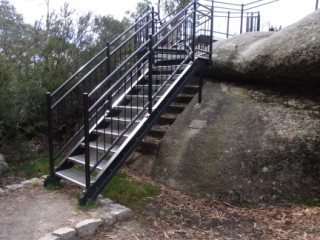Rate of deaths from stairs = 56 fatalities per 100 million miles.
Rate of deaths driving a car = 0.56 fatalities per 100 million miles.
Stair data: 3,800 fatalities per year over 1,953 billion stair uses* which covers 6.832 billion miles allowing a stair to be 119″ high (~10′) with a 7″-11″ stair ratio (32deg pitch) giving a travel distance along the stair of 222″ thus 286 stair flights per mile. *Centre for Building Technology, National Bureau of Standards 1979, Guidelines for Stair Safety (1975 data). The comparison assumes that stair safety has not improved 1975-2011. If there is newer data it would be useful.
Driving data: 16,430 driver (not passenger, motorcyclist,etc) fatalities over 2,946 billion mile for USA 2011. The denominator here is the total travel hence will not be accurate as it will include motorcycles (which are not on the top line) but motor vehicle only distance seems hard to locate. The total road fatality rate is 1.1


Was there a breakdown of deaths by age?
Hi Andrew, Not in that document.
In studies of falls in transit terminals*, based on the number of passengers in each age group, the age-related risks are as follows:
about the same as the passenger numbers for males aged 18-24 & females aged 18-42;
under-represented: males aged 25-61; and
over-represented: males and females under 18 and over 61 and females 43-61.
*Port Authority of New York and New Jersey, Federal Transit Administration, US Department of Transportation 1985, Pedestrian Falling Accidents at Transit Terminals, Federal Transit Administration, New York.
Pingback: Relative risks: driving, smoking, skydiving, stairs or going to hospital. | safedesign
John great blog very interesting and thought prevoking. Questions on the stair rate of deaths per 100 million miles. Is it really comparable to a 100 million miles in a car as it is easier and more efficient to acheive than walking stairs, so can they be compared fairly? And how would they compare if you applied a frequency rate to the miles you are likley to achieve in a car compared to walking stairs over your lifetime? Is this a fair way to compare or evaluate the risk, or would you need break it down further?
Hi Rodney, Thank you for the encouraging feedback!
Yes, the total exposure to driving – for most people – will be more. And if it is greater than 100 times more distance than on stairs then the total risk will be greater.
We could do time exposure as well (per hour). In that case stairs remain about ten times more dangerous. For the time exposure comparison we need the ratio of the average speed of both methods. I think about 10:1 would be of the right order. Perhaps your trip computer measures average speed since new? Mine shows an average over 30,000 miles of about 25mph. Compared to say 2.5mph for walking – perhaps a bit less on stairs – but close enough just for the sake of an order of magnitude estimation we have a ratio of something in the order of 10:1.
Total risk v incremental risk.
The danger of something can be considered in terms of total or incremental. I think when we decribe something as being “dangerous” we usually mean incremental (i.e. per mile, per hour).
For example in total, playgrounds in the USA are involved in 320,000 times more injuries to 5-14 year olds than chainsaws. But that does not mean that a 10 year old is safer playing with a chainsaw than on a playground! It does not tell us anything either way but common knowledge would suggest that exposure to playgrounds is vastly greater. So to know the incremental danger the exposure figures would be needed.
Ok great so, stairs are 10 times more dangerous than cars. Thats interesting and it helps to achieve a perspective to different activities I suppose. That will be a useful analogy. Is there any other application for this type of information that can be used or applied to?